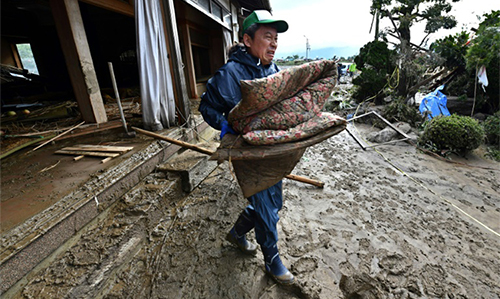Japan: The death toll from Typhoon Hagibis, the worst storm in decades to rise to nearly 70 by October 15.
Typhoon Hagibis, accompanied by record rain and strong winds over decades, hit central and eastern Japan on October 12, causing at least 176 rivers to collapse, flooding residential areas and landslides in 11 provinces. In addition to the death victims, there is an increase in the number and storms left 15 people missing and 211 injured.

Japanese rescue workers clean up after Hagibis on October 15 Photo: AFP.
About 138,000 households were dehydrated and 34,000 households lost power after the storm, as the weather began to turn cold in northern Japan. The prime minister's office said more than 3,000 people were rescued after the disaster.
The increased amount of mud after the storm, along with debris mixed in mud and water, made rescue work more difficult. A total of 110,000 Japanese police, fire and defense forces (SDF) were mobilized to join the search for the missing.
"I couldn't believe it, the water was rising very fast," a man in Fukushima told NHK.
Fukushima prefecture north of Tokyo is one of the worst hit areas due to Typhoon Hagibis. At least 18 people have died in Fukushima, where up to 14 break points along the Abukuma River. Including a mother and two children were swept along the flood. Rescuers have found the body of the mother and child, there is another boy still missing. NHK said the people who died in Fukushima were mostly elderly. The main highways in Fukushima are still closed today, while some return to work the first day after the storm, children also wear uniforms and walk to school.
Panasonic said floods had damaged an electronics group's factory in an industrial park in Koriyama. Renowned carmakers including Toyota, Nissan, Honda and Subaru said there was no significant damage at the factory and still operated normally.
Speaking in parliament, Prime Minister Shinzo Abe warned that the impact of Hurricane Hagibis on the economy could be prolonged and the government will do everything to recover from the storm, bringing people back to normal life as soon as possible. good. Japan's Finance Minister, Taro Aso, said that he has set aside $ 4.6 billion for disaster recovery from Typhoon Hagibis and will consider increasing it if necessary.
While rain is expected to decline in parts of Japan affected by Hurricane Hagibis on October 15, temperatures will likely drop sharply in many areas this week, even abnormally.



 DaliaAvila
DaliaAvila







